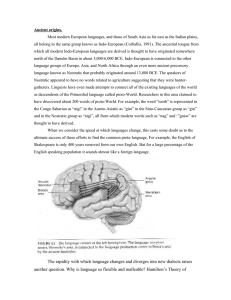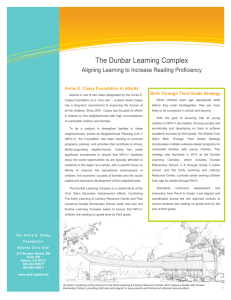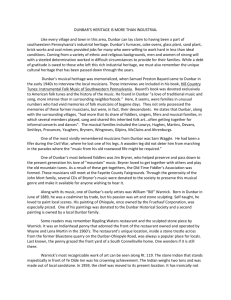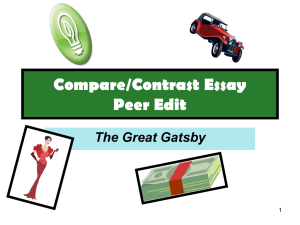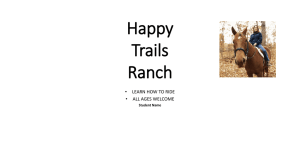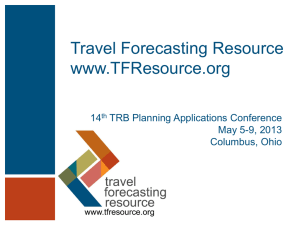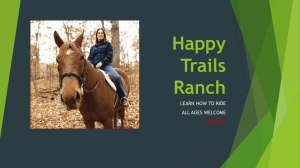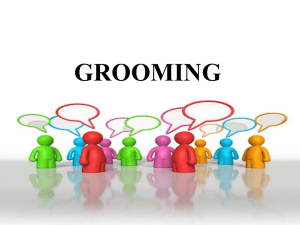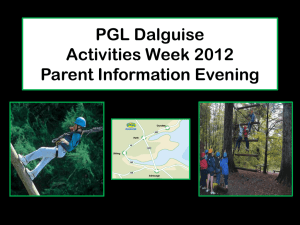Robin Dunbar
advertisement
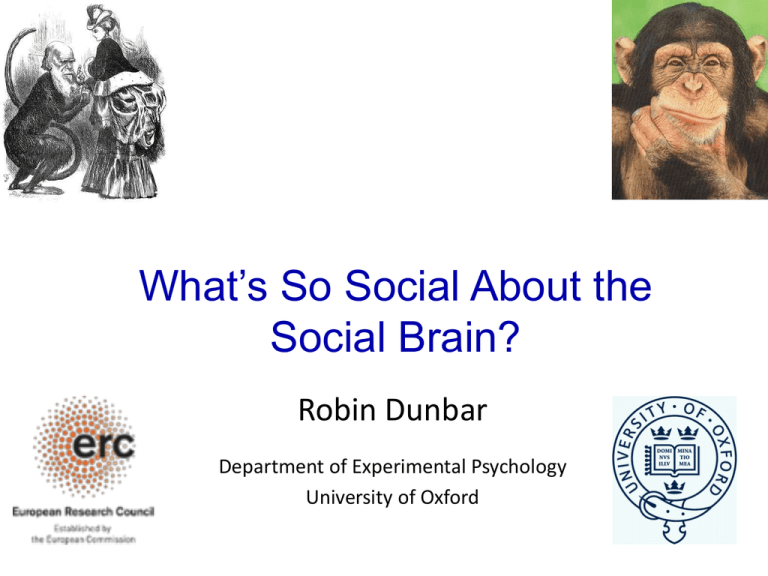
What’s So Social About the Social Brain? Robin Dunbar Department of Experimental Psychology University of Oxford Social Cognitive Neuroscience A Challenge • • • SCN has become one of the big stories in neuropsychology and neuroimaging But what exactly is the nature of sociality in this context? The Challenge: Have we focussed on the right indices of sociality? • Sociality typically viewed as a dyadic interaction • But in fact it is about relationships in complex networks Histological data Stephan et al (1981) The Social Brain Hypothesis Dunbar (2010) Neocortex Ratio An explanation for the evolution of unusually large brains in primates Histological data Fuster (1982) MRI data Rilling & Insel (1999) Evidence: Group size is a function of neocortex volume in three different datasets Prefrontal Cortex volume (cc) Neocortex grey matter volume (cc) The Social Brain IS Costly Reaction Times Mentalising Factual In the mentalising network, there is a parametric effect of task mentalising level on fMRI signal Lewis et al.(submitted) What Does the Social Brain Predict for Humans? • Predicted group size for humans is ~150 [Dunbar’s Number] All these have mean sizes of 100-200 Neolithic villages 6500 BC 150-200 Modern armies (company) 180 Hutterite communities 107 ‘Nebraska’ Amish parishes 113 business organisation <200 ideal church congregations <200 Domesday Book villages 150 C18th English villages 160 GoreTex Inc’s structure 150 Research sub-disciplines 100-200 Small world experiments 134 Hunter-Gatherer communities 148 Xmas card networks 154 “Reverse” Small World Experiments Killworth et al (1984) Hunter-Gatherer Societies Dunbar (1993) 10 9 8 Number of Cases Are Human Groups 150? Xmas Card Networks 6 5 4 3 2 1 35 32 30 37 0- 34 5- 32 0- 29 5- 27 0- 24 5- 22 0- 19 5- 17 0- 14 5- 4 9 4 9 4 9 4 9 4 9 4 Maximum Network Size 27 25 22 20 17 15 12 9 -9 4 -7 9 -4 12 0- 75 50 24 0- 10 0 25 Hill & Dunbar (2003) 7 Human Social Groups http://www.youtube.com/watch?v=ApOWWb7Mqdo “Reverse” Small World Experiments Killworth et al (1984) These all have mean sizes of 100-200 10000 Neolithic villages 6500 BC 150-200 1000 Modern armies (company) 180 Hunter-Gatherer Hutterite communities 107 Societies 100 ‘Nebraska’ Amish parishes 113 Dunbar (1993) business organisation <200 10 ideal church congregations <200 Doomsday Book villages 150 Luckily, Individual Tribes C18th English villages 160 it’s a 1hoax…. 0 10 20 30 stunt! GoreTex Inc’s structure 150 It was an advertising Research sub-disciplines 100-200 10 9 Xmas Card Networks 7 6 5 4 3 for posterity…..? 1 35 32 30 37 0- 34 5- 32 0- 29 5- 27 0- 24 5- 22 0- 19 5- 17 0- 14 5- 4 9 4 9 4 9 4 9 4 9 4 Maximum Network Size 27 25 22 20 17 15 12 9 -9 4 -7 9 -4 12 0- 75 50 10 0 24 0- Hill & Dunbar (2003) 2 25 Small world experiments 134 Hunter-Gatherer communities 148 friends recorded XmasHer card 152 networks 154 Number of Cases 8 The Social Brain is Really About…. The behavioural complexity of relationships ….group size is an emergent property Grooming clique size Tactical Deception 0.20 Coalitions Relative neocortex size 0.15 0.10 0.05 Partialling out phylogeny, body mass, etc by PGLS 0.00 -0.05 No Yes Coalitions NO Error bars: +/- 1.00 SE Byrne & Corp (2003) Kudo & Dunbar (2000) YES Dunbar & Shultz (2007) The Fractal Periodicity of Group Sizes Xmas card dataset In all these mammals, scaling ratio 3 Social Groupings Database Xmas Card Hunter-gatherer Database groups Hill, Bentley & Dunbar (2008) Zhou, Sornette, Hill & Dunbar (2005) Scaling ratio = exp(2π/) = 3.2 and 3.3 Scaling ratio = 3.3 Hamilton et al (2007) Social Complexity in Primates • Primate societies are hierarchically embedded • As neocortex size increases, groups become socially more fragmented (grooming cliques get smaller) • Somehow, they manage to balance a two-tier system Lehmann & Dunbar (2009) The Expanding Circles • Our relationships form a hierarchically inclusive series of circles of increasing size but decreasing intensity [ie quality of relationship] Intensity EGO 5 15 • The 150 = limit on personalised, reciprocated relationships • 1500 = limit on memory for faces? 50 150 500 1500 How Bonding Works Bonding is a dual-process mechanism An emotionally intense component [= endorphins via grooming] A cognitive component [= cognition brain size] The Limits to Intentionality... A natural limit at 5th order intentionality: “I intend that you believe that Fred understands that we want him to be willing to [do something]…” [level 5] The Role of Social Cognition [Mentalising] The Orders of Intentionality • Frequency of failure 20 10 Intentional competence correlates with social network size …..Does the hardware correlate too? 0 1st 2nd 3rd 4th 5th 6th 7th 8th 9th Level of intensionality 30 Clique size Scanner dataset 20 10 Powell et al (2011) Stiller & Dunbar (2007) 0 0 2 4 6 8 Level of intensionality 10 Intentionality and Frontal Lobe Volume 3T T1-weighted MRI Howard et al’s (2003) parcellation method, using Cavalieri method for estimating volumes PFC defined by leading edge of corpus callosum Intentionality correlates with orbitofrontal PFC, but not with dorsal frontal Powell et al (2010) Insights from Neuroimaging Powell et al (2012) • In a stereological analysis of gross volume: best predictor of BOTH intentional competence and network size is orbitofrontal PFC volume • In a fine-grained VBM (voxel) analysis: overlap of network size and intentional competence in the ventromedial PFC Lewis et al (2010) Path Analysis of Imaging Data Powell et al (2012) • There is a clear causal sequence: hardware cognition [software] behaviour Networks Correlate with Brain Regions Social group size in macaques Internet Friends Sallet et al. (2012) Just HOW are they doing this? Kanai et al. (2011) Why Time is Important 50 Social Time (%) • Grooming as the bonding agent in primates • Grooming time is determined by group size Predicted for Humans 40 30 20 10 • …with an upper limit at about 20% of total daytime 0 0 20 40 60 80 100 Group Size 120 140 160 Grooming Time in Humans? Social Time (%) • If we bonded our groups using the standard primate mechanism ….we would have to spend 43% of the day grooming 50 Predicted for Humans 40 30 20 10 0 0 20 40 60 80 100 Group Size 120 140 160 Grooming Time in Humans? Social Time (%) • In fact, we spend only 20% of our time in social interaction …..from a sample of 7 societies from Dundee to New Guinea 50 Predicted for Humans 40 30 20 10 • How do we bond our super-large communities? 0 0 20 40 60 80 100 120 140 Group Size Dunbar (1998) 160 How Grooming Works 12 Number of Grooming Partners 50 Predicted for Humans Social Time (%) 40 30 20 10 An experimental study with monkeys 10 8 6 Opiates block social drive; 4 2 0 Sal Naltrex Sal Sal Morph 0 0 20 40 60 80 100 120 140 160 Group Size • endorphins are relaxing • They create a psychopharmacological environment for building trust? Keverne et al (1989) Opiate-blockers enhance social drive μ-receptor Activation in Light Stroking • • • • Preliminary results from a first PET study (at Turku, Finland) Carfentanil as opiate antagonist with particular affinity to μ-receptors [for βendorphins] Significant response in some key regions that suggest endorphin activation even to light touch Probably exploiting the same c-afferent fibre system as found widely in mammals [responds ONLY to light touch as in stroking movements of grooming] The Three Ways We’ve Bridged the Gap Religion and its rituals 50 Modern humans 40 Archaic humans The Bonding Gap H. erectus 30 Music and dance 20 Australopiths 10 -.5 0.0 .5 1.0 1.5 2.0 2.5 3.0 3.5 Millions Years BP Laughter a cross-cultural trait shared with chimpanzees Music and Laughter Trigger Endorphin Uptake Dunbar et al (submitted A) Music Laughter Perform Comedy Control Edinburgh Fringe Dunbar et al (2012b) Singing vs prayer Drumming Listening to vs listening music vs video Neutral Dunbar et al (2012a) Procedure: • pain test • video/activity pain re-test • Factual vs Comedy Videos So….why not just get your kicks on your own? Plenty of people do…. …BUT doing it together seems to ramp up the effects Synchony Ramps up the Endorphins? Change in pain threshold before and after 45 mins rowing work-out on ergometers in the gym: Alone vs in a virtual boat Alone Group 2007 Boat Race Alone Group Cohen et al (2010) Comparative brains: • Dr Susanne Shultz • Dr Boguslaw Pawlowski Social Networks and Bonding: • Dr Sam Roberts • Dr Russell Hill • Prof Alex Bentley • Dr Wei Zhou • Prof Didier Sornette • Dr Emma Cohen • Dr Anna Machin Imaging: • Amy Birch • Rachel Browne • Dr Penny Lewis • Dr Joanne Powell • Dr Marta García-Fiñana • Prof Neil Roberts • Dr Lauri Numennmaa With Thanks to…. For funding: British Academy EPSRC ESRC Leverhulme Trust EU-FP7 ERC
